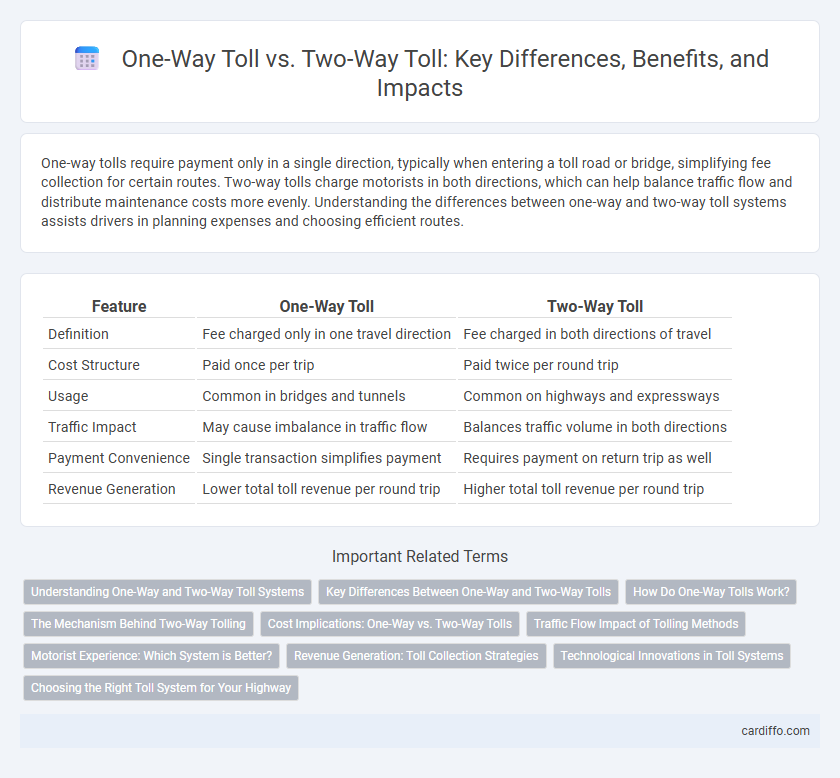One-way tolls require payment only in a single direction, typically when entering a toll road or bridge, simplifying fee collection for certain routes. Two-way tolls charge motorists in both directions, which can help balance traffic flow and distribute maintenance costs more evenly. Understanding the differences between one-way and two-way toll systems assists drivers in planning expenses and choosing efficient routes.
Table of Comparison
| Feature | One-Way Toll | Two-Way Toll |
|---|---|---|
| Definition | Fee charged only in one travel direction | Fee charged in both directions of travel |
| Cost Structure | Paid once per trip | Paid twice per round trip |
| Usage | Common in bridges and tunnels | Common on highways and expressways |
| Traffic Impact | May cause imbalance in traffic flow | Balances traffic volume in both directions |
| Payment Convenience | Single transaction simplifies payment | Requires payment on return trip as well |
| Revenue Generation | Lower total toll revenue per round trip | Higher total toll revenue per round trip |
Understanding One-Way and Two-Way Toll Systems
One-way toll systems charge vehicles only in one direction, simplifying toll collection and reducing congestion at toll plazas. Two-way toll systems require payment both ways, distributing toll fees across round trips and often balancing revenue more evenly. Understanding these systems helps drivers anticipate costs and optimize travel routes on toll roads.
Key Differences Between One-Way and Two-Way Tolls
One-way tolls require payment only when traveling in a single direction, often simplifying traffic flow and reducing toll collection infrastructure. Two-way tolls impose charges in both directions, ensuring balanced revenue from both entry and exit points but potentially increasing user costs and congestion. The key difference lies in toll placement and collection efficiency, impacting overall transportation economics and road usage patterns.
How Do One-Way Tolls Work?
One-way tolls charge drivers only when they travel in a specified direction, typically on the entrance or exit of a toll road, bridge, or tunnel, eliminating the need to pay on return trips. This system simplifies toll collection and reduces congestion, as vehicles are billed once per trip rather than twice. One-way tolls often utilize electronic toll collection systems like RFID tags or license plate recognition, ensuring seamless traffic flow while accurately capturing toll revenue.
The Mechanism Behind Two-Way Tolling
Two-way tolling requires drivers to pay toll fees in both directions of travel, effectively doubling the revenue potential compared to one-way tolling. This mechanism uses electronic toll collection systems that automatically charge vehicles upon entry and exit, ensuring precise billing for road usage. By capturing tolls at multiple points, two-way tolling promotes fair cost distribution based on actual road consumption and helps fund infrastructure maintenance more sustainably.
Cost Implications: One-Way vs. Two-Way Tolls
One-way tolls charge drivers only when traveling in a single direction, often resulting in lower upfront costs but potentially higher expenses on return trips. Two-way tolls impose fees in both directions, increasing total travel costs but simplifying budgeting and toll management for frequent commuters. Evaluating travel patterns and frequency helps determine which toll structure offers better cost efficiency for individual drivers.
Traffic Flow Impact of Tolling Methods
One-way toll systems often lead to increased congestion at toll plazas in the charged direction due to concentrated traffic flow, whereas two-way toll systems distribute traffic more evenly, reducing bottlenecks and improving overall roadway efficiency. Traffic flow in one-way tolling can experience peak period surges, intensifying delays and driver frustration, while two-way tolling balances revenue collection and smoother traffic distribution across both directions. Implementing two-way tolls typically results in a more consistent traffic pattern and decreases the likelihood of spillback congestion on approach lanes.
Motorist Experience: Which System is Better?
One-way toll systems streamline motorist experience by requiring payment in a single direction, reducing stops and congestion on return trips. Two-way tolls can cause delays in both directions, increasing travel time and driver frustration, especially during peak hours. Data indicates that one-way tolling improves traffic flow and minimizes bottlenecks, enhancing overall efficiency for commuters.
Revenue Generation: Toll Collection Strategies
One-way toll systems generate revenue by charging drivers only at a single point, often maximizing collection efficiency on high-traffic routes. Two-way toll systems collect fees in both directions, increasing total revenue potential but requiring more complex infrastructure and enforcement. Selecting between one-way and two-way toll strategies depends on traffic patterns, operational costs, and projected revenue goals for sustainable toll collection management.
Technological Innovations in Toll Systems
Technological innovations in toll systems have revolutionized One-Way Toll and Two-Way Toll collection through automated electronic toll collection (ETC) using RFID and GPS-based systems, enhancing traffic flow and reducing congestion. Advanced license plate recognition and mobile payment platforms enable seamless toll payments without physical barriers, improving efficiency in both toll types. Integration of real-time data analytics allows dynamic pricing adjustments, optimizing revenue and managing traffic demand effectively.
Choosing the Right Toll System for Your Highway
Choosing the right toll system for your highway involves evaluating traffic patterns and revenue goals to determine if a one-way toll, charging only in a single direction, or a two-way toll, charging in both directions, is more effective. One-way tolls simplify operations and reduce congestion on the toll plaza, while two-way tolls generate consistent revenue and distribute costs evenly among all users. Considering factors such as traffic volume, driver behavior, and maintenance costs ensures optimal toll system implementation that balances efficiency and profitability.
One-Way Toll vs Two-Way Toll Infographic

 cardiffo.com
cardiffo.com